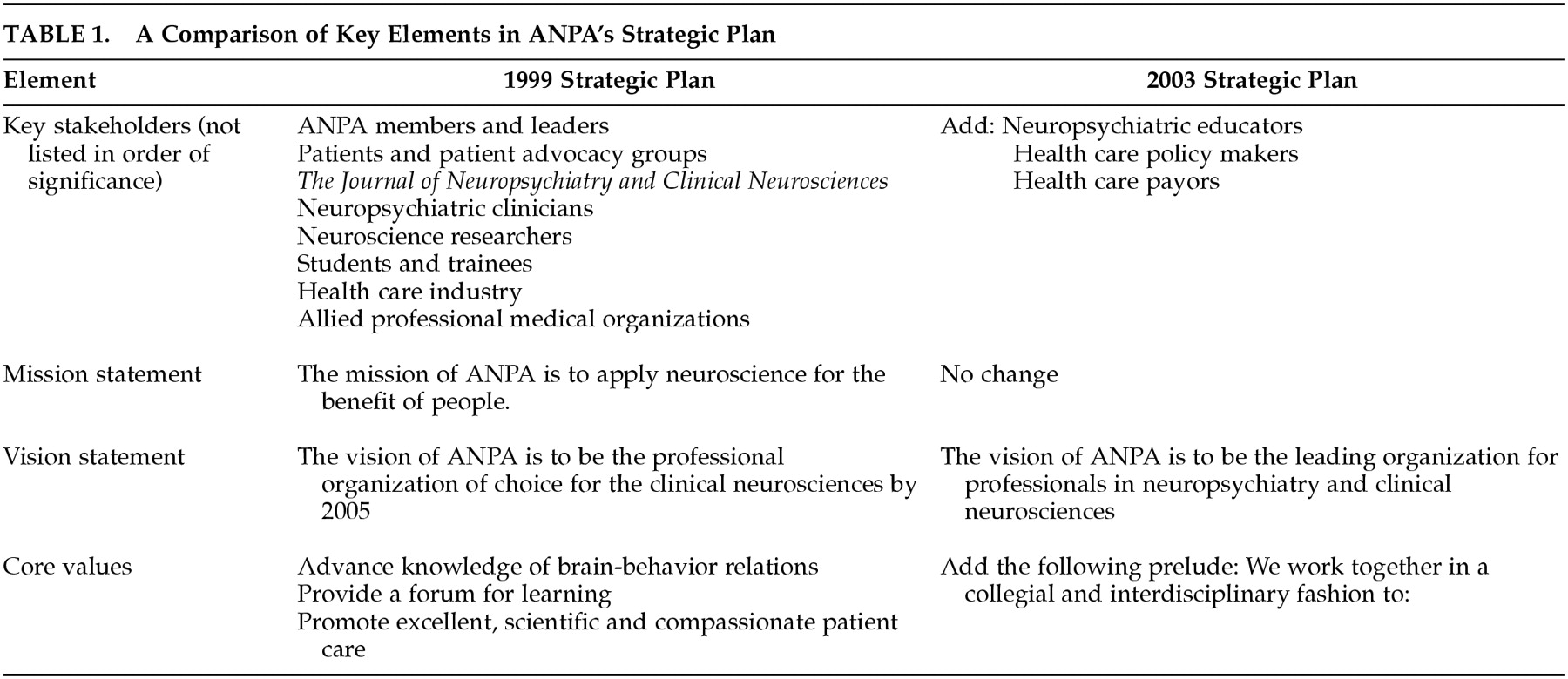Success is never an accident. It is always the result of high intention, sincere effort, intelligent direction, skillful execution, and the vision to see obstacles as opportunities.
On Feb. 2, 2003, the Executive Committee of the American Neuropsychiatric Association (ANPA) convened a half-day retreat of all Fellows and Committee Chairs of the Association during its annual meeting in Honolulu. The purpose of this special meeting was to update the rolling Strategic Plan of the Association published in 1999.
1 Participants included 12 Fellows and Committee Chairs (Karen Anderson, M.D.; David Arcinegas, M.D.; Sheldon Benjamin, M.D.; John Campbell, M.D.; Ed Coffey, M.D.; Laura Flashman, Ph.D.; Ed Lauterbach, M.D.; Paul Malloy, Ph.D.; Tom McAllister, M.D.; Alya Reeve, M.D.; Richard Restak, M.D.; and Jonathan Silver, M.D.) as well as Jim Duffy, M.D.; Sandy Bornstein, Secretary of ANPA; and Bob Bornstein, Ph.D., Executive Secretary of the International Neuropsychological Society. Participants prepared for the retreat by reviewing literature on strategic planning distributed in advance. The retreat was led by Dr. Coffey and co-facilitated by Dr. Campbell.
We began the retreat with a review of the Association's stakeholders, core values, and mission and vision statements as conceptualized in 1999. The group made minor changes to these key elements, as described in
Table 1. We expanded the list of key stakeholders to include neuropsychiatric educators and health care payors and policy makers. We made no change to the mission statement, which continues to serve us well. We revised the vision statement slightly to include the term “neuropsychiatry” and to remove 2005 as a target date. We also added a prelude to our listing of core values to describe the collegial and interdisciplinary way in which we work together.
We then formed breakout groups to review progress on our current strategic goals, and by all accounts we have made very good progress indeed. As described in recent ANPA newsletters, the Education Committee has developed a self-assessment examination, available to members on ANPA’s new web site developed and maintained by Paul Malloy. (Additional accomplishments by the Education Committee include the development of a model curriculum, bibliography, and standards for fellowship training in neuropsychiatry.) The Research Committee continues to publish timely and evidenced-based reviews of issues relevant to our members. The Association has achieved a solid financial footing, and we are developing an endowment to ensure our future financial health. Under the leadership of the Membership Committee, we have increased our membership to 678 paid members through 2002, which is well on our way to our goal of 1,000 members.
The entire group then reconvened for our final task of the afternoon, viz. establishing our strategic goals for the next 3–5 years. After a thoughtful and energetic discussion, a list of possible goals was developed and submitted to the Executive Committee for prioritization. In a series of subsequent sessions, the Executive Committee reviewed this preliminary list and developed the following key goals for ANPA for 2003 thru 2008.
1.
Continue to provide exceptional value to ANPA members by producing an annual meeting of superior quality.
2.
Continue to grow the membership of the Association, with a particular focus on member retention and satisfaction.
3.
Develop and implement a plan for certification in neuropsychiatry. The options here range from formal accreditation by the American Board of Psychiatry and Neurology to “internal” certification by ANPA.
In summary, the second ANPA Strategic Planning Retreat was a great success. We assessed our progress; affirmed our mission; refined our vision, key stakeholders, and core values; and identified key strategic goals to help us realize that vision. Important work remains however. We must communicate this information to all ANPA members. This report is an important first step in this communication process, and we will continue to review progress on our strategic plan at our annual meetings. Working with our effective committee structure, we must also develop tactics to achieve each of these strategic goals as well as the resources to support our implementation plans. The latter issue is a particular challenge given that ANPA remains an association led by volunteers. Still, given the energy, creativity, expertise, and commitment of our members, we are certain that ANPA will succeed.


